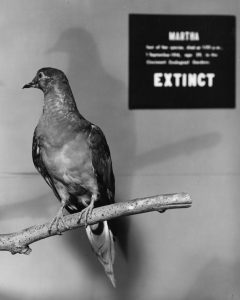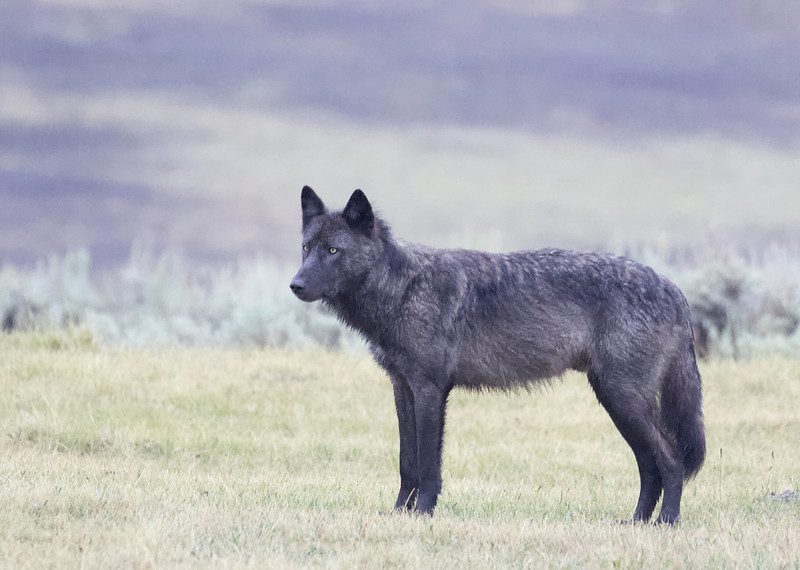Imagine a world without manatees, grizzly bears, or bald eagles. These important and iconic animals once faced the threat of extinction in the United States and a world without them could have been reality, had it not been for protection efforts. Federal efforts to protect species from extinction began at the turn of the 20th century and expanded greatly over the years.
While new threats to species survival continue to emerge in modern times, this blog will look back on the history of protecting wildlife from extinction.
Before the Endangered Species Act Protection Efforts
The Lacey Act
The first federal laws that protected endangered species came through the Lacey Act in 1900, which outlawed the transportation of illegally taken wildlife across state lines. This was in response to public panic about rapidly decreasing numbers of the passenger pigeon, which unfortunately was declared extinct in 1914 after the last known member of the species, Martha, died in the Cincinnati Zoo.
Bald Eagle Going Extinct
The bald eagle, the national symbol of the United States since 1782, was also facing extinction in the early 20th century. At the time, eagles were incorrectly perceived as threats to domestic livestock and were often shot to eliminate this threat. Coupled with loss of nesting habitat, the bald eagle population diminished significantly. In response, the Bald Eagle Protection Act of 1940 was enacted, which made it a federal offense to kill, sell, or possess the birds (including their feathers, nests, and eggs).
How did Silent Spring Encourage Environmentalism?
A vital development in the protection of endangered species came with Rachel Carson’s 1962 book Silent Spring, which delved into the impacts of pesticides, particularly DDT, on wildlife, the environment, and human health. DDT had become popular in the U.S. after World War II but contaminated the waterways, which in turn poisoned wildlife such as bald eagles when they ate contaminated fish. Poisoned eagles produced eggshells so weak that many broke during incubation. Silent Spring is considered one of the most influential books in the modern environmental movement and Carson’s research helped outlaw the use of DDT in 1972.

Endangered Species Preservation Act of 1966
Finally during this time period, the Endangered Species Preservation Act of 1966 was passed. This Act was the first comprehensive endangered species legislation in the U.S. and the precursor to the Endangered Species Act in 1973. With the act came the first federal list of endangered and protected species: 14 mammals, 36 birds, 3 reptiles, 3 amphibians, and 22 fishes.
Endangered Species Act of 1973 (ESA of 1973)
In 1973, the Endangered Species Act (ESA) was signed by President Richard Nixon. Superseding all earlier acts, the 1973 Act established protections for fish, wildlife, and plants and provided the necessary monetary allocations and interagency planning protocols to carry out protections for endangered species. While the ESA has been amended since its creation, it still functions today as the primary path for species protection in the United States. A species is added to the endangered list either when federal scientists determine a species is at risk or when an individual or organization submits a petition that the government deems warranted.
Government Agencies that Protect Endangered Species
Two government entities manage the recovery plans for animals on the endangered species list: The U.S. Fish and Wildlife Service (for land and freshwater species) and the National Oceanic and Atmospheric Administration (for saltwater species). There are currently over 1,300 endangered species listed.
Endangered Species Act Success Stories
A 2019 study found that the ESA directly prevented the extinction of 291 species in the U.S. and has saved 99% of the species under its protection. There are some incredible success stories because of the ESA.
Bald Eagle and the Endangered Species Act
Bald eagle protection efforts were so successful that the bird was removed from the endangered species list entirely in 2007, considered completely recovered.
California Condor, Endangered Species Act
In 1982, California condors were on the absolute brink of extinction with only 22 condors in the wild while today, thanks to conservation efforts, there are more than 300.
Gray Wolf, Endangered Species Act
Gray wolves were added to the endangered species list in 1974 and were successfully reintroduced to Yellowstone National Park in the early 1990s, helping expand their population numbers significantly.

Endangered Species Act Shortcomings
There is more to wildlife health than the prevention of extinction – a 2022 study found that since the ESA’s creation, only around 54 endangered U.S. species have been declared fully recovered and removed from the list. The study noted a variety of factors contributing to low recovery rates, including a “pattern of not protecting species until their populations have reached very low levels” and inadequate funding for recovery actions.
Species are also sometimes removed from the endangered species list, not because they recover but because they’ve gone fully extinct. For example, the U.S. Fish and Wildlife Service removed 21 species in October 2023 from the endangered species after determining they were extinct. These removals due to extinction are sometimes used to criticize the efficacy of the ESA. In reality, many of the species delisted in 2023 were already considered possibly extinct or too severely threatened to recover prior to the passing of the ESA and their addition to the ESA endangered species list. While the ESA had no chance to help the delisted species, their extinction serves as a warning that species protection efforts must start earlier, well before a species’ population numbers are catastrophically low.
Climate Change and Endangered Species – Future Threats
The U.S. Fish and Wildlife Service released an article earlier this year saying climate change is “one of the greatest environmental stressors we face today.” The article outlined the ways that climate change models heavily impact decisions to preemptively begin conservation efforts for species that face extinction due to the effects of climate change. The Fish and Wildlife service also stressed that climate change is not a future threat but is happening now, as evidenced by “extreme weather, sea-level rise, droughts, and wildfires.”
2023 marked the 50th anniversary of the Endangered Species Act. There is a lot to be hopeful about, despite the environmental challenges facing us in the upcoming 50 years. For smaller ways to help endangered species at home, check out this list from the Endangered Species Coalition on ways we can all help endangered species, starting in our own backyards.
Image credits: Martha’s 1956 display at the Smithsonian Institution (Martha, A Passenger Pigeon is Public Domain); Bald eagle (Bald eagle, Big Bear Lake area by San Bernardino Nat’l Forest is Public Domain); Wolf (Gray Wolf – Canis lupus by Gregory “Slobirdr” Smith is licensed under CC BY-SA 2.0)


